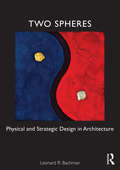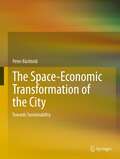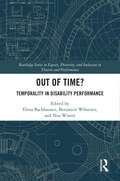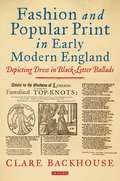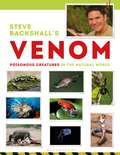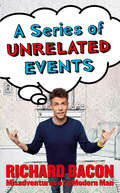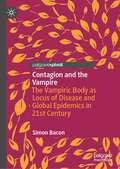- Table View
- List View
Dream Worlds: Production Design For Animation
by Hans BacherA truly unique visual delight offering insight into the development of animation classics like Bambi, Beauty and the Beast, The Lion King, Lilo and Stitch as well as a tantalizing examination of unfinished Disney projects.
Dream Worlds: Production Design for Animation
by Hans BacherA truly unique visual delight offering insight into the development of animation classics like Bambi, Beauty and the Beast, The Lion King, Lilo and Stitch as well as a tantalizing examination of unfinished Disney projects.
Constructing the Architect: An Introduction to Design, Research, Planning, and Education
by Leonard R. BachmanUnlike books that concentrate on the monuments and other artefacts that architects produce, Constructing the Architect focuses on architecture as a disciplinary and professional process, an institution of society, and a career of learning and mastery. In doing so, it offers a lens into the architecture of architecture. Mapping architecture as a coherent whole, Leonard Bachman shows that the field must be understood as four mutually reinforcing modes of inquiry: design, research, strategy, and education. Within this framework, he explains how institutions and actors hold differing perspectives on the critical discourse that advances architecture and identifies the various tensions and leverage points for change within the discipline. Featuring over 100 illustrations to support understanding of this highly visual subject, this is an essential introduction for any student seeking to understand what it means to be an architect and to enter the professional discourse.
Constructing the Architect: An Introduction to Design, Research, Planning, and Education
by Leonard R. BachmanUnlike books that concentrate on the monuments and other artefacts that architects produce, Constructing the Architect focuses on architecture as a disciplinary and professional process, an institution of society, and a career of learning and mastery. In doing so, it offers a lens into the architecture of architecture. Mapping architecture as a coherent whole, Leonard Bachman shows that the field must be understood as four mutually reinforcing modes of inquiry: design, research, strategy, and education. Within this framework, he explains how institutions and actors hold differing perspectives on the critical discourse that advances architecture and identifies the various tensions and leverage points for change within the discipline. Featuring over 100 illustrations to support understanding of this highly visual subject, this is an essential introduction for any student seeking to understand what it means to be an architect and to enter the professional discourse.
Integrated Buildings: The Systems Basis of Architecture
by Leonard R. BachmanAn "anatomical" study of building systems integration with guidelines for practical applications Through a systems approach to buildings, Integrated Buildings: The Systems Basis of Architecture details the practice of integration to bridge the gap between the design intentions and technical demands of building projects. Analytic methods are introduced that illustrate the value, benefit, and application of systems integration, as well as guidelines for selecting technical systems in the conceptual, schematic, and design development stages of projects. Landmark structures such as Eero Saarinen's John Deere Headquarters, Renzo Piano's Kansai International Airport, Glenn Murcutt's Magney House, and Richard Rogers's Lloyd's of London headquarters are presented as part of an extensive collection of case studies organized into seven categories: Laboratories Offices Pavilions Green Architecture High Tech Architecture Airport Terminals Residential Architecture Advanced material is provided on methods of integration, including an overview of integration topics, the systems basis of architecture, and the integration potential of various building systems. An expanded case study of Ibsen Nelsen's design for the Pacific Museum of Flight is used to demonstrate case study methods for tracing integration through any work of architecture. Visually enhanced with more than 300 illustrations, diagrams, and photographs, Integrated Buildings: The Systems Basis of Architecture is a valuable reference guide for architecture and civil engineering students, as well as architects, engineers, and other professionals in the construction industry.
Two Spheres: Physical and Strategic Design in Architecture
by Leonard R. BachmanExplaining the connection between physical and strategic design, this book proposes an aesthetic connection between two equal aspects of architectural design: the Real and the Ideal. Addressing architectural thinkers from the broad realms of academia and practice, it is suitable either as a seminar text, a guide to contemporary design issues, or as a theoretical work. Beginning with a historical perspective, the book looks at some of the key conflicts in architectural thought that were brought about by postindustrial change. The discussion shifts to clearly describe the forms of complexity, how these have interacted with architecture and the possibilities in fully embracing complexity in architectural practice. Although there are many books focusing on complexity science, there are few that focus on the relationship between complexity and design and none which take such a comprehensive approach.
Two Spheres: Physical and Strategic Design in Architecture
by Leonard R. BachmanExplaining the connection between physical and strategic design, this book proposes an aesthetic connection between two equal aspects of architectural design: the Real and the Ideal. Addressing architectural thinkers from the broad realms of academia and practice, it is suitable either as a seminar text, a guide to contemporary design issues, or as a theoretical work. Beginning with a historical perspective, the book looks at some of the key conflicts in architectural thought that were brought about by postindustrial change. The discussion shifts to clearly describe the forms of complexity, how these have interacted with architecture and the possibilities in fully embracing complexity in architectural practice. Although there are many books focusing on complexity science, there are few that focus on the relationship between complexity and design and none which take such a comprehensive approach.
Erdbebensicherung von Bauwerken
by Hugo BachmannDie fachgerechte Erbebensicherung von Bauwerken ist heute nicht mehr eine Frage der Erkenntnisse, sondern eine Frage der Ausbildung von Bauingenieuren und Architekten und somit der Umsetzung vorhandenen Wissens in die Praxis. Durch wenige gezielte Massnahmen konzeptioneller und konstruktiver Art sowie durch eine problemgerechte Berechnung und Bemessung kann das Schadenrisiko drastisch vermindert und ein hoher Schutzgrad gegen Einsturz erreicht werden. Das Buch ist auf die Bedürfnisse des praktisch tätigen Bauingenieurs ausgerichtet; mit seiner starken Gewichtung des erbebengerechten Entwurfs hilft es, konzeptionelle Fehler und Mängel zu vermeiden, da diese auch durch eine noch so ausgeklügelte ingenieurmässige Berechnung und Bemessung nicht kompensiert werden können. Das Buch gibt aber auch zahlreiche Hinweise zu aktuellen Forschungsthemen.
The Coherence of EU Regional Policy: Contrasting Perspectives on the Structural Funds (Regions and Cities #Vol. 16)
by John Bachtler Ivan TurokThis book brings together a rich selection of up-to-date practical experience of EU regional policy from across Europe. It provides different perspectives on the design and operation of regional development strategies under the Structural Funds, from people closely involved in studying, managing or advising on the process at EU, national and regional levels. It therefore offers a more comprehensive and detailed understanding of the structural policies than has been available hitherto. This will prove particularly useful to researchers, practitioners and students interested in European regional policies and processes.
The Coherence of EU Regional Policy: Contrasting Perspectives on the Structural Funds (Regions and Cities)
by John Bachtler Ivan TurokThis book brings together a rich selection of up-to-date practical experience of EU regional policy from across Europe. It provides different perspectives on the design and operation of regional development strategies under the Structural Funds, from people closely involved in studying, managing or advising on the process at EU, national and regional levels. It therefore offers a more comprehensive and detailed understanding of the structural policies than has been available hitherto. This will prove particularly useful to researchers, practitioners and students interested in European regional policies and processes.
The Space-Economic Transformation of the City: Towards Sustainability
by Peter BachtoldCity planning is the key-stone to tackle the question of climate-change and to involve adequate action. In Part I of this book, the theory of space-economy is presented. Opening up a new conceptual and operational toolbox for policy makers, practitioners and scholars, the theory of space-economy is based on a rigorously structured thinking and acting in the field of sustainable urban planning and architecture.Europe has the greatest experience in sustainable city planning worldwide. In Part II, four of the most remarkable experiences (Vauban in Freiburg i.B., Kronsberg in Hannover, Western Harbour in Malmö, Hammarby Sjöstad in Stockholm) are presented, dissected conceptually and operationally a radically new way. The interest of the approach is not limited to European countries.In Part III is developed a project in Asia, in Ho Chi Minh City, faced with dramatic threats due to climate change and rapidly growing tidal and sea-level rise. Based on the experiences presented in Part II, the approach is integrated in this completely different context, thus becoming fully effective at a much bigger scale.
Classic French Fashions of the Twenties (Dover Pictorial Archive Ser.)
by Atelier BachwitzThis fine reproduction of a 1929 French fashion catalog features styles for all occasions. More than 50 color illustrations showcase elegant dresses, gowns, and coats from the designers of an influential and internationally renowned studio. Designs include a promenade and party frocks of silk, lace, and taffeta, all in the era's distinctive dropped-waist, knee-length mode, forming a panorama of fashions favored by flappers, society matrons, and other women of the 1920s.A rare source of authentic period styles, this volume will prove an excellent guide for designers, costume historians, and collectors of vintage apparel. Color images of Jazz Age fashions are few and far between, and these full-page illustrations offer clear views of trimmings, seaming, and other details. Notes on each model include information about the costume's intended season and occasion, fabrics, and accessories.
Usability-Engineering in der Medizintechnik: Grundlagen - Methoden - Beispiele (VDI-Buch)
by Claus BackhausErgonomisch gestaltete Medizintechnik führt zu effizienteren Arbeitsabläufen, erhöht die Patientensicherheit und reduziert die Arbeitsbelastung. Das Buch erläutert, wie Medizintechnik an die Bedürfnisse der Nutzer und Anwender angepasst werden kann. Durch das beschriebene Vorgehen ist es möglich, sowohl die Anforderungen der harmonisierten Normen DIN EN 62366 und DIN EN 60601-1-6 umzusetzen als auch neue Lösungsansätze für die Entwicklung innovativer Medizintechnik zu erarbeiten. Die Umsetzung wird anhand ausgewählter Praxisbeispiele erörtert.
Out of Time?: Temporality In Disability Performance (Routledge Series in Equity, Diversity, and Inclusion in Theatre and Performance)
by Elena BackhausenOut of Time? has many different meanings, amongst them outmoded, out of step, under time pressure, no time left, or simply delayed. In the disability context, it may also refer to resistant attitudes of living in “crip time” that contradict time as a linear process with a more or less predictable future. According to Alison Kafer, “crip time bends the clock to meet disabled bodies and minds.” What does this mean in the disability arts? What new concepts of accessibility, crip futures, and crip resistance can be staged or created by disability performance? And how does the notion of “out of time” connect crip time with pandemic time in disability performance? The collective volume seeks to respond to these questions by exploring crip time in disability performance as both a concept and a phenomenon. The book tackles the topic from two angles: on the one hand from a theoretical point of view that connects performance analysis with crip and performance theory, on the other hand from a practice-based perspective of disability artists who develop new concepts and dramaturgies of crip time based on their own lived experiences and observations in the field of the performing and disability arts. The book gathers different types of text genres, forms, and styles that mirror the diversity of their authors. Besides theoretical and academic chapters on disability performance, the book also includes essays, poems, dramatic texts, and choreographic concepts that ref lect upon the alternative knowledge in the disability arts.
Out of Time?: Temporality In Disability Performance (Routledge Series in Equity, Diversity, and Inclusion in Theatre and Performance)
by Elena Backhausen Benjamin Wihstutz Noa WinterOut of Time? has many different meanings, amongst them outmoded, out of step, under time pressure, no time left, or simply delayed. In the disability context, it may also refer to resistant attitudes of living in “crip time” that contradict time as a linear process with a more or less predictable future. According to Alison Kafer, “crip time bends the clock to meet disabled bodies and minds.” What does this mean in the disability arts? What new concepts of accessibility, crip futures, and crip resistance can be staged or created by disability performance? And how does the notion of “out of time” connect crip time with pandemic time in disability performance? The collective volume seeks to respond to these questions by exploring crip time in disability performance as both a concept and a phenomenon. The book tackles the topic from two angles: on the one hand from a theoretical point of view that connects performance analysis with crip and performance theory, on the other hand from a practice-based perspective of disability artists who develop new concepts and dramaturgies of crip time based on their own lived experiences and observations in the field of the performing and disability arts. The book gathers different types of text genres, forms, and styles that mirror the diversity of their authors. Besides theoretical and academic chapters on disability performance, the book also includes essays, poems, dramatic texts, and choreographic concepts that ref lect upon the alternative knowledge in the disability arts.
Fashion and Popular Print in Early Modern England: Depicting Dress in Black-Letter Ballads (Dress Cultures Ser.)
by Clare BackhouseFashion featured in black-letter broadside ballads over a hundred years before fashion magazines appeared in England. In the seventeenth century, these single-sheet prints contained rhyming song texts and woodcut pictures, accessible to almost everyone in the country. Dress was a popular subject for ballads, as well as being a commodity with close material and cultural connections to them. This book analyses how the distinctive words and images of these ballads made meaning, both in relation to each other on the ballad sheet and in response to contemporary national events, sumptuary legislation, religious practice, economic theory, the visual arts and literature. In this context, Clare Backhouse argues, seventeenth-century ballads increasingly celebrated the proliferation of print and fashionable dress, envisioning new roles for men and women in terms of fashion consumption and its importance to national prosperity. The book demonstrates how the hitherto overlooked but extensive source material that these ballads offer can enrich the histories of dress, art and culture in early modern England.
Thinking in Threes: The Power of Three in Writing
by Brian BackmanThis practical resource helps students see the importance of “the rules of three” in writing successful essays. The student-friendly activities in this book give students essay-writing strategies organized in easy-to-remember groups of three. The book includes many activities and games that help point out the importance of the number three in our language.With Thinking in Threes, powerful writing strategies are as easy as 1-2-3! Some of the rules of three explained in this book include:three steps for brainstorming,three “Ps” of a thesis statement,three parts of an essay,three paragraphs in the body of an essay,three ways to connect paragraphs and sentences,three types of evidence to support topic sentences,three qualities of a good example,three things to include in a quotation,three ways to hook the reader in an introduction,three ways to write fluent sentences,three ways to write successful conclusions, andthree phrases for completing a timed writing assignment.The goal of Thinking in Threes is to empower students to write great essays in your classroom!Grade 5-Adult
Thinking in Threes: The Power of Three in Writing
by Brian BackmanThis practical resource helps students see the importance of “the rules of three” in writing successful essays. The student-friendly activities in this book give students essay-writing strategies organized in easy-to-remember groups of three. The book includes many activities and games that help point out the importance of the number three in our language.With Thinking in Threes, powerful writing strategies are as easy as 1-2-3! Some of the rules of three explained in this book include:three steps for brainstorming,three “Ps” of a thesis statement,three parts of an essay,three paragraphs in the body of an essay,three ways to connect paragraphs and sentences,three types of evidence to support topic sentences,three qualities of a good example,three things to include in a quotation,three ways to hook the reader in an introduction,three ways to write fluent sentences,three ways to write successful conclusions, andthree phrases for completing a timed writing assignment.The goal of Thinking in Threes is to empower students to write great essays in your classroom!Grade 5-Adult
Steve Backshall's Venom
by Steve BackshallTV presenter Steve Backshall needs no introduction following his performances on TV series such as Deadly 60 and Lost Land of … This is a reformatted, redesigned edition of a popular title. Poison is an everyday part of the animal world, and an essential tool for hunting and defence. A wide variety of insects, reptiles and amphibians use toxins to subdue their prey or to stop becoming prey to another predator. Even some mammals and birds resort to poison as a means of securing a meal or deterring attack!From species such as the King Cobra, Lionfish, Fat-tail Scorpion and Poison Dart-frog to the diminutive but lethal Black Widow Spider, the author takes a fascinating look at the different types of natural venoms. On a tour of the world's continents, he looks at over 60 of the most venomous creatures, describing their main characteristics and explaining how they administer their venom and what its effects are. Stunning colour photographs and exciting accounts of Steve's own encounters with some of these animals bring the world of natural venom alive.
Steve Backshall's Venom
by Steve BackshallTV presenter Steve Backshall needs no introduction following his performances on TV series such as Deadly 60 and Lost Land of … This is a reformatted, redesigned edition of a popular title. Poison is an everyday part of the animal world, and an essential tool for hunting and defence. A wide variety of insects, reptiles and amphibians use toxins to subdue their prey or to stop becoming prey to another predator. Even some mammals and birds resort to poison as a means of securing a meal or deterring attack!From species such as the King Cobra, Lionfish, Fat-tail Scorpion and Poison Dart-frog to the diminutive but lethal Black Widow Spider, the author takes a fascinating look at the different types of natural venoms. On a tour of the world's continents, he looks at over 60 of the most venomous creatures, describing their main characteristics and explaining how they administer their venom and what its effects are. Stunning colour photographs and exciting accounts of Steve's own encounters with some of these animals bring the world of natural venom alive.
The Fascination of Film Violence
by Henry BaconThe Fascination of Film Violence is a study of why fictional violence is such an integral part of fiction film. How can something dreadful be a source of art and entertainment? Explanations are sought from the way social and cultural norms and practices have shaped biologically conditioned violence related traits in human behavior.
Finnish Cinema: A Transnational Enterprise (Palgrave European Film and Media Studies)
by Henry BaconThis book presents an expert analysis of the transnational aspects of Finnish cinema throughout its history. As a small nation cinema, Finnish film culture has, even at its most nationalistic, always been attached to developments in other film producing nations in terms of production and distribution as well as genres and aesthetics. Recent developments in film theory offer exciting new approaches and methodologies for the study of transnational phenomena in the field of film culture, both past and present. The authors employ a wide range of cutting edge methodologies in order to address the major issues involved in transnational approaches to film culture. Until recently, much of this research has focused on globalization and questions related to diasporic cinema, while transnational issues related to small nation film cultures have been marginalized. This study focuses on how small nation cinemas have faced the dilemma of contributing to the construction and maintenance of national culture and identity, while responding to audience tastes largely shaped by foreign cinemas.With Finland’s intriguing political placement between East and West, along with the high portion of film history preserved in Finnish archives, this thoroughly contextualized multidisciplinary analysis of Finnish film history serves as an illuminating case study of the transnational aspects of small nation cinemas.
A Series of Unrelated Events: Misadventures Of A Modern Man
by Richard BaconHave you ever been stitched up to the national press by your best mate?Or unintentionally upset a band with a slip of the tongue on a live TV show?Or ruined a dinner party by transforming everything alcoholic into water?Hello. I’m Richard Bacon and this is A Series of Unrelated Events. All of the stories are true. All of them happened to me. I’ve made the mistakes so you don’t have to (you’re welcome). So now, if you should ever find yourself sobbing on top of a box of gherkins in the stockroom of a Mansfield McDonald’s… having a Twitter conversation with your mum while she’s pretending to be an illiterate dog… performing stand-up to an audience who are funnier than you are… or just letting down all of the children of Great Britain……you’ll know exactly what to do.
Contagion and the Vampire: The Vampiric Body as Locus of Disease and Global Epidemics in 21st Century
by Simon BaconThis book examines how the vampire has always been connected to ideas of infection, pollution and disease—even more so in the 21st century where it expresses the horrors of unseen and unstoppable disease and the foreboding and anxiety that accompany viral outbreaks and wider epidemics. Here the vampire gives physical form to the contagion and associated anxieties around the perceived causes and spread of disease, where it can take on many forms from animal to pestilential particulate matter, creeping shadows and even malignant weather systems. If blood is life, it is the body of the vampire that is death. This timely study looks at how and why the vampire continues to fulfil this function and posits that the true patient zero in the 21st century is no longer the dangerous, ancient, outsider from the East but is the undying monster that is Western culture itself.



